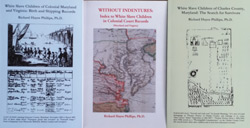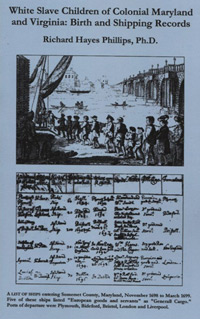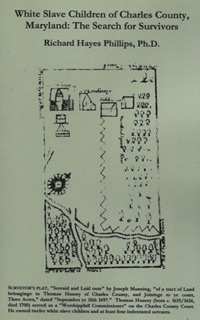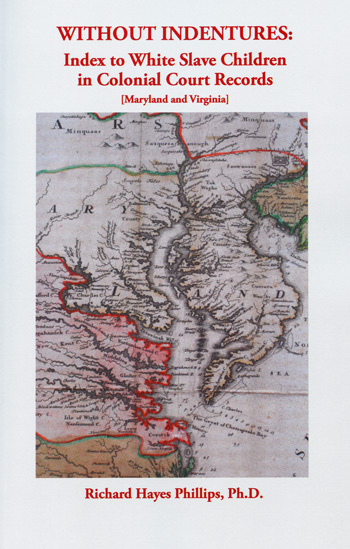
As I blogged in 2014, soon after Dr. Richard Hayes Phillips wrote his first book on the topic, if you’ve got Maryland or Virginia Colonial roots, you really need to see the results of his research. He’s just written two new books on White Slave Children – many of whom many be our ancestors! Following are descriptions of the three books now in print. Since the first book was so popular, we’ve bundled the 3 volumes at 15% off. This sale runs through Tuesday, January 26. If you only need one or two of the books, you can get them at 10% off. Just click on the links.
Wondering if your ancestors might have been white slave children? As I did in 2014, I will personally check the index for surnames for you. As before, email me with the surname in the subject line of the email. Please – just the surname, no more. I will reply with just one word – yes or no. If Yes – I’ll note which book or books the surname is found in. Those requesting a surname search should note that I will not be able to reply on Saturday or Sunday, but will make the reply on Monday. Send index checking requests to me at Lmeitzler@gmail.com .

Picking up where he left off in his ground-breaking book Without Indentures: Index to White Slave Children in Colonial Court Records, Dr. Richard Hayes Phillips has now taken the story back even further – back to the scenes of the original crimes-kidnapping of children to be sold into slavery (ca. 1660-1720). This new book is entitled White Slave Children Of Colonial Maryland And Virginia: Birth And Shipping Records.
In his original book, which I found to be most helpful, Dr. Phillips identified 5,290 “servants” without indentures, transported against their will. He culled that evidence from the Court Order Books of colonial Maryland and Virginia, where the county courts were authorized to examine the children, adjudge their ages, and sentence them to slavery for a number of years. The younger the child, the longer the sentence. In this book, compiled from shipping records found in the Library of Congress, the Bristol [England] Record Office, and elsewhere, the author has identified 170 ships that carried white slave children to the plantations of colonial Maryland and Virginia. The shipping records itemize the unfortunate kids as “cargo” and specify the import duties paid to the Royal Naval Officers for each child. The white slave ships sailed from no fewer than seventeen ports of departure in England.
The places from which the children were taken and their adjudged ages on the dates of their court appearances have enabled Dr. Phillips to conduct a targeted search of the birth and baptismal records. In all, he has matched more than 1,400 children with the parish or town records. The book also contains an exposé of the colonial shipping industry. Among the child traffickers were the Mayors of Bristol and Bideford and the Governor of Virginia.
Birth and Shipping Records – which begins with a detailed discussion of the author’s sources and detective-like methodology and concludes with a surname index – is arranged according to the localities in the British Isles from which the victims were confiscated. It is a volume that will help researchers trace their white slave heritage back even further than before, and it cries out for correctives to be written in American history books regarding our colonial origins and our treatment of one another.
Click here to order at 10% off. Sale runs through January 26.
Click here to order a bundle of the three books at 15% off, plus a $2 shipping savings. Sale runs through January 26.
—–

Also brand new from Dr. Phillips is White Slave Children Of Charles County, Maryland: The Search For Survivors. In this second companion volume to Without Indentures: Index to White Slave Children in Colonial Court Records (see also White Slave Children of Colonial Maryland and Virginia: Birth and Shipping Records), Dr. Richard Hayes Phillips takes the story forward–examining the treatment of children kidnapped and sold into slavery, and identifying those who survived.
In his original book Dr. Phillips identified 5,290 “servants” without indentures, transported against their will to places in Virginia and Maryland, including Charles County. For this book Dr. Phillips has indexed seventy-five years of handwritten records from Charles County, Maryland (1658-1733). The records are nearly complete and most have never been transcribed before–872 “servants” without indentures were brought to this county, and 333 were owned by the judges on the very court that sentenced them to slavery.
This book contains three indexes–with detailed abstracts–to Charles County servants with or without indentures (recaptured runaways, petitions for freedom, complaints of abuse or neglect), and six indexes to all residents of the county (vital records, witnesses who stated their ages, grantee index to deeds, gifts of livestock, deaths and estates, and orphan children). Most of these records have been microfilmed, scanned, and posted online by the Archives of Maryland. With brief citations, the reader is steered to online images of actual handwritten records.
All nine new indexes have been cross-checked with Dr. Phillips’ master list of 872 “servants” without indentures, from which he has compiled an Encyclopedia of Survivors. This section of the work, one of the longest, assembles all that is known about the lives of the children following their release from servitude. Many of these biographical sketches trace descendants for several generations, refer to acquisitions of land, and contain other details useful to genealogists. The alphabetically arranged chapter entitled Vital Records is a godsend for anyone tracing Charles County roots, whether or not your ancestor suffered white enslavement. Dr. Phillips has also included full-fledged biographies of three of the worst abusers of child labor among the county officials, an exposé of how the system of white slavery operated, and instances of resistance by the survivors. Thus begins the dark era of white slavery on the North American continent.
Click here to order at 10% off. Sale runs through January 26.
Click here to order a bundle of the three books at 15% off, plus a $2 shipping savings. Sale runs through January 26.
——–
As most of my readers know, Without Indentures: Index to White Slave Children in Colonial Court Records, is one of my favorite source books. It was published in 2013, and I refer to it regularly when researching my Maryland and Virginia families. Following is a review I did of the book when it first appeared:
Every parent has the fear that their child might disappear. And I can tell you that grandparents also have the same fear. As a grandparent of 3 small children, when they are under my care, I watch them like the proverbial hawk.
Believe it or not, based on an English law passed in 1659, minor children could be kidnapped by justices of the peace if they happened to be begging, or just seemed to be vagrant. These children were shipped to the plantations as servants without indentures. According to the author of “Without Indentures: Index to White Slave Children in Colonial Court Records (Maryland and Viginia),” the younger the child, the longer the sentence, and the county courts were the judges of their ages. The judges decided their age – and many of the kids were placed in servitude to the very judges who sentenced them.
Over 5000 children were picked up in Ireland, Scotland, England and New England, and shipped to Virginia and Maryland between 1660 to 1720. The names of these kids, their assigned age, the owner, and the date they appeared in court are found in Richard Phillips brand new book, “Without Indentures: Index to White Slave Children in Colonial Court Records (Maryland and Virginia).” The book also contains an index to ships and their captains that imported the children. A surname index is included.
I got really excited about the volume when, on page, 88, I found an entry for Charles County, Maryland that reads thus: Cornute, Hendrick, 14 June 1670, age 20, John Okeane. I’ve got to wonder, is this possibly a progenitor, sibling or cousin pertaining to my Cornute/Cornett family line? This Cornute is on of the earliest I’ve seen in America. This is a lead I didn’t have before.
Exacting information is given in the book as to where to locate digitized, microfilmed and in some cases original copies of the County Court books from where to the information for this book was taken. Now I can take the next step and view the original document. In my Cornute case mentioned above, the data is actually digitizing and available online!
The following is from the table of contents:
- Preface
- Guide to the Records
- Guide to the Indexes
- Northampton County, VA
- Accomack County, VA
- Somerset County, MD
- Talbot County, MD
- Queen Anne’s County, MD
- Kent County, MD
- Cecil and Dorchester Counties, MD
- Baltimore County, MD
- Anne Arundel County, MD
- Prince George’s County, MD
- Charles County, MD
- Stafford County, VA
- Westmoreland County, VA
- Northumberland County, VA
- Lancaster County, VA
- Old Rappahannock County, VA
- Richmond County, VA
- Essex County, VA
- Middlesex County, VA
- York County, VA
- Charles City County, VA
- Henrico County, VA
- Surry County, VA
- Isle of Wight County, VA
- Norfolk County, VA
- Princess Anne County, VA
- Index to Ship Captains
- Index to Ship Arrivals
- Surname Index
- Appendix: Jacobite Rebels
I recommend this book to anyone researching early colonial American relatives, especially for those with New England, Maryland and Virginia ancestry.
Without Indentures: Index to White Slave Children in Colonial Court Records (Maryland and Virginia); by Richard Hayes Phillips, Ph.D.; Baltimore MD; 2013; 320 pp, 5.5×8.5; Item #:GPC4606.
